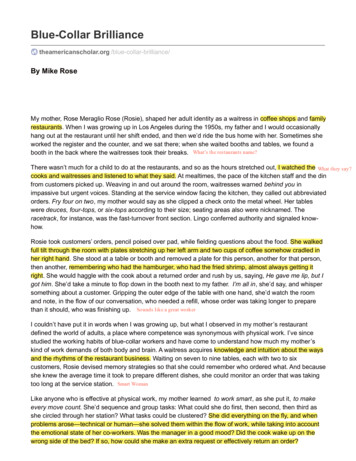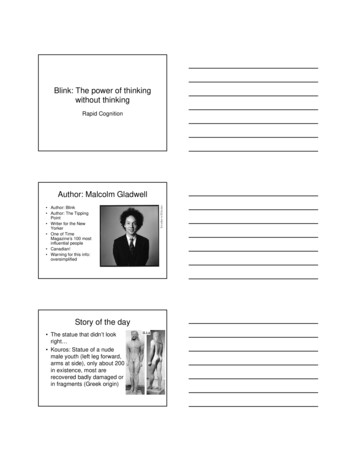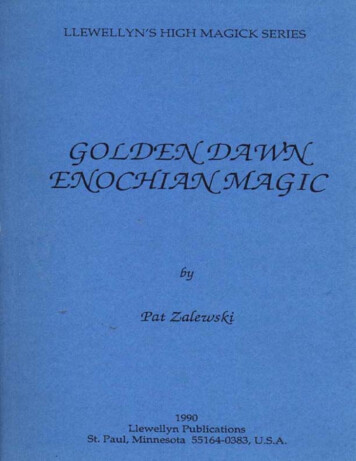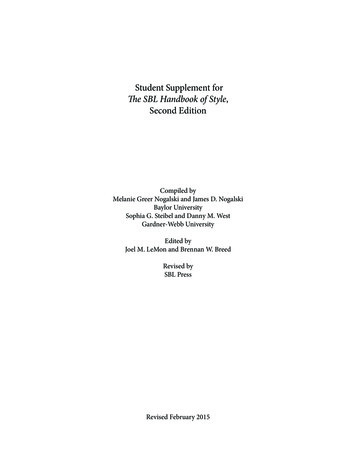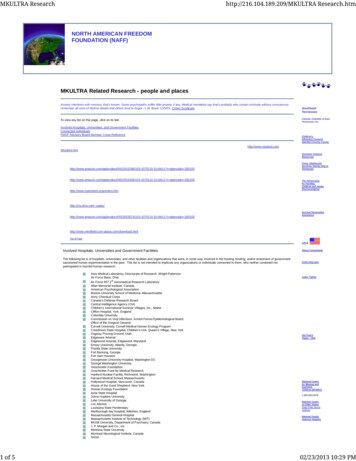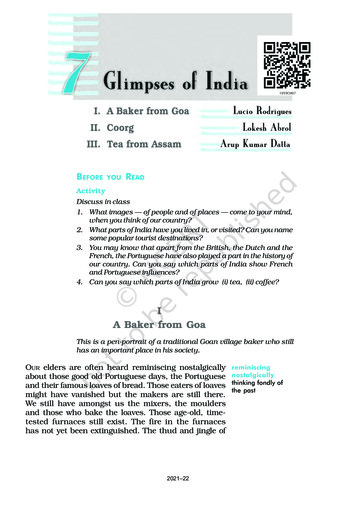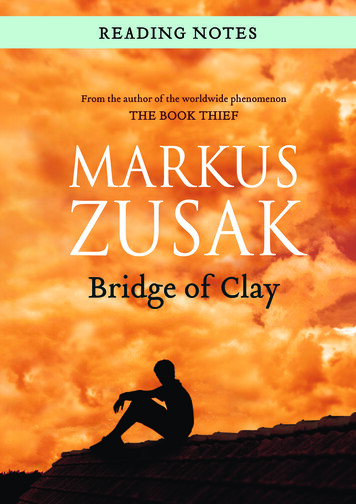
Transcription
READING NOTESFrom the author of the worldwide phenomenonTHE BOOK THIEFMARKUSZUSAKBridge of Clay
Bridge of ClayBlurbLet me tell you about our brother.The fourth Dunbar boy named Clay.Everything happened to him.We were all of us changed through him.The Dunbar boys bring each other up in a house run by their own rules. A family oframshackle tragedy – their mother is dead, their father has fled – they love and fight,and learn to reckon with the adult world.It is Clay, the quiet one, who will build a bridge; for his family, for his past, for his sins.He builds a bridge to transcend humanness. To survive.A miracle and nothing less.Markus Zusak makes his long-awaited return with a profoundly heartfelt and inventivenovel about a family held together by stories, and a young life caught in the current: a boyin search of greatness, as a cure for a painful past.The AuthorMarkus Zusak is the bestselling author of six novels, including The Book Thief andThe Messenger. His books have been translated into more than forty languages, to bothpopular and critical acclaim. He lives in Sydney with his wife and two children.2
Bridge of ClayPlot SummaryAfter the death of their mother and abandonment by their grieving father, the five Dunbarbrothers spend several shambolic years raising themselves in a small house in a fictionalhorseracing quarter of Sydney.Amid the mess, the fights, and an assortment of unusual pets, the Dunbar boys have begunto rebuild their lives – except for the middle brother, Clay, who is keeping a painful secret.It is he who helped their mother to die when their father couldn’t bring himself to do it,and while knowing he would do the same again, Clay cannot forgive himself.When their father, Michael Dunbar, reappears in their lives and asks the brothers to helphim build a bridge on his new property, all but Clay refuse. Risking rejection from hisbrothers, Clay travels to Michael’s property and together they start building the bridge andslowly healing old wounds.On regular trips back to Sydney, Clay begins to reconnect with his brothers and spendstime with his best friend, apprentice jockey Carey Novac, who lives across the road. Butjust as healing seems to be within reach, Carey is killed in a riding accident. His griefalmost overwhelming, Clay seeks solace and redemption in the building of his bridge,which he and Michael finally complete just before the coming of flooding rains.ThemesStorytellingBridge of Clay is full of beginnings and endings that are not necessarily told chronologically.If there’s one thing I’ve come to learn, though, it’s that if life goes on in our aftermaths,it goes on in our worlds before it. (Page 450)While neither Penny’s death nor Michael’s leaving are described till the end of the novel,both have already occurred when the story begins. Penny’s death could be described as adefinite ending, but Michael’s leaving is said to be a ‘constant beginning’ (page 357).1. What is Markus Zusak suggesting by structuring the novel in this way? What do youthink Zusak is suggesting about the nature of stories?2. Events yet to be described for the reader, even if they have already happened, are oftensuggested to be ‘in waters still to come’. Why do you think Markus Zusak might haveused this expression?3
Bridge of Clay3. Several books have a role to play in Bridge of Clay: Homer’s The Iliad and The Odyssey,and the fictional book The Quarryman. What is the significance of each of these booksin the novel?4. There is also one other important book underlying these three: it’s not named, butthere are hints all the way through in the plot and the language. What do you thinkthat book is, and where/how does it appear in Bridge of Clay? (Clue: read the openingsentence.)‘I’m sorry,’ he whispered to both of them, ‘I’m so sorry, I’m sorry, I’m sorry!’ The pegwas clenched tight in his hand, and he addressed them, lastly, again. ‘I promise, I’ll tellyou the story,’ he said, ‘how I brought you both home Achilles.’That mule was never for Tommy. (Page 415)5. What do you think Clay means when he says this to his absent parents? What is hetrying to achieve through the story of the getting of Achilles?6. How would you describe the role of storytelling in the novel? What does it mean toPenny? To Clay? To Matthew?Bridge of Clay is brimming with story and stories: it contains an infinite number, some ofwhich are only hinted at, or are not otherwise the focus of the book – think, for example,of the original owner of Achilles weeping as the boys lead him away (how did he acquireAchilles, how long did he have him for?), or of how Tommy decided to become a socialworker (what made him choose that career path?).7. Flesh out some of these untold stories in your imagination. For example, what do youthink Clay did in his years travelling while his brothers waited for him? What do youthink Michael did in the years after he left Archer Street?8. Are there any stories which you wish Markus Zusak had spent more time on? Or anythat felt less relevant to you? Discuss the choices authors must make when writing anovel.Boyhood, and what it means to be male in today’s worldIt’s a mystery, even to me sometimes, how boys and brothers love. (Page 309)9. Life for the five brothers in the parentless Dunbar household is sometimes chaotic,unpredictable and haphazard, but there is deep warmth, affection and joy to be foundthere too. In what ways do the Dunbar boys look after each other and hold each otherup?4
Bridge of Clay10. Why do you think Clay and his other brothers are so sure that Matthew will beat himup when he returns home from his father’s property? And why then, and not beforeClay leaves? The fight appears in a chapter titled ‘The Violence of Brothers’. What doesMarkus Zusak mean by this, do you think?11. Clay’s brothers write to him on pages 235–236. What does each letter tell us about thebrothers and their relationship with Clay? How do their letters compare with Carey’s?Life, death, grief and guiltThe two most important women in Clay’s life – Penny Dunbar and Carey Novac – bothdie, though in very different circumstances: Penny’s death is painful and prolonged, Carey’sis unexpected and instantaneous.12. Is one kind of loss easier to cope with than the other, i.e. a drawn-out illness or asudden death?13. Clay believes he bears a certain amount of culpability for both deaths: discuss theextent to which you think he is guilty in relation to either of them.But then they returned to hurting again.There was guilt for enjoying anything.Especially the joy of forgetting. (Page 512)14. What does this extract say about the nature of grief and the process of grieving?‘He’s gone, Clay, he killed us. He murdered us.’ I forced myself to say it. I forcedmyself to like it. ‘What we were – there’s nothing left.’ (Page 361)15. Michael leaves the Dunbar household after Penny’s death, such is his grief, giving birthto his nickname, ‘The Murderer’: do you think he deserves it? What is the irony of thatnickname?16. Why does Matthew force himself to say, and like, the words above? Why is it necessaryfor him to do so?17. Why might Michael’s abandonment of the boys be seen differently by Clay?5
Bridge of ClayAs Clay stood, Tommy asked him; all just part of the ritual.He pointed towards his pocket.‘You want me to mind it for you, Clay?’Clay said nothing, but told him.The answer was always the same. (Page 46)18. Clay always carries a peg in his pocket: why is it so precious to Clay? Why does hekeep it near him?19. There are many other ‘totems’ or ‘mementos’ in the book (for example, the engravedlighter, the Monopoly iron, the button from Penny’s dress). Identify as many as you can.What do you think Markus Zusak is saying about memory, history, grieving, and evenabout lore?[Rory] shoved a hand right into my heart. ‘He needs to feel it here.’There was suddenly such gravity, such pain in him, and it came like the force of apiano. The quietest words were the worst. ‘He needs to hurt nearly enough to killhim,’ he said, ‘because that’s how we goddamn live.’ (Page 460)20. What do you think Markus Zusak’s point is in this extract? What is he saying aboutgrief? About life?CharactersClay is obviously the central character of this book, but Bridge of Clay has a very largecast of other characters; all the members of the Dunbar family, the Statue of Stalin, CareyNovac’s family, the members of the racing community, Claudia Kirkby, to name a few.21. Which character was your favourite, and why?22. Are there any characters you would have liked to know more about?ClayYes, always for us there was a brother, and he was the one – the one of us amongstfive of us – who took all of it on his shoulder. (Page 3)As a boy, as I said, he was the best of us. (Page 263)23. Why do you think Clay kept his secret about Penny’s death for so long? What signs arethere early on that he has a secret of this magnitude?6
Bridge of Clay24. The deaths of Penny and Carey are pivotal moments in Clay’s life, but what signs arethere that he was a singular person even before these traumatic events? The role Clayplayed in Penny’s death obviously shaped him as a person, but can it also be argued thathe ended up playing that role because of the type of person he was?‘You’re thinking of going?’Clay watched me.He watched but said nothing while I tried, as I’d often done lately, to somehowunderstand him. (Page 99)25. Why do you think Clay felt he had to go to his father?What was there to know when it came to Clayton, our brother?Questions had followed him for years now, like why did he smile but never laugh?Why did he fight but never to win?Why did he like it so much on our roof?Why did he run not for a satisfaction, but a discomfort – some sort of gateway to painand suffering, and always putting up with it?Not one of those enquiries, however, was his favourite. (Page 21)26. Having finished the book, do you think you know the answers to these questions?What is Clay’s favourite enquiry? And what is the answer to it?[I]t didn’t matter how much we hurt him, we couldn’t hurt him. Or how much weheld him; we couldn’t hold him. (Page 359)It was training, it was escaping.It was perfect pain and happiness. (Page 368)27. What does the book suggest is the reason Clay runs and fights almost beyondendurance? Is it just to escape his grief, or is it something else, something more, too?‘We live the lives of the Slaves.’The bridge was all they had. (Page 398)28. What does Clay mean by this? Why do you think Clay loves Michelangelo’spermanently half-finished Slaves so much?29. What do you think the bridge represents to Clay? Why is he building it?30. One of the pivotal moments in this book is when Carey Novac tells Clay that hisbridge will be made of him. But what is Clay Dunbar made of – and how many bridgesdoes he actually build?7
Bridge of ClayPenelope LesciuszkoThey’d brought her in the metronome, and it was one of the boys who said it. I thinkhis name was Carlos.‘Breathe in time with this, Miss.’ (Page 314)31. The students from the notorious Hyperno High obviously love their teacher: why dothink that might be? What does that tell us about Penny?Her ambition of reading both The Iliad and The Odyssey was her constantimmigrant Everest.How typical then, and perfect.This, after all, was Penelope. (Page 123)32. Penelope’s story is both extraordinary and ordinary, in its own way. What does it haveto say about the journeys asylum seekers have to make? What does this tell us aboutPenny in particular?Carey NovacOnce, when she came storming through the field, on a mare by the name of StunGun, a jockey lost his whip in front of her, and it struck her below the chin. It causedher a moment’s distraction, and the loss of the horse’s momentum.She finished fourth, but alive, and pissed off. (Page 353)33. What sort of a person is Carey?She pointed casually over, at her roughed-up, trampled-down dad, and already she wason her way:To here and Clay, and Archer Street.She said, ‘I’m gonna be just like him.’ (Page 427)34. What is it about Carey that you think draws Clay to her? What personality traits dothey share? How are they different?In Carey Novac, Clay had found someone who knew him, who was him, in all butone life-defining way. He also knew that if she could have, she’d have traded anythingto share that with him as well:The reason he carried the peg. (Page 120)The only way he could live with himself was knowing he’d tell her [Carey, about thepeg] at the end – when she’d need to leave him behind. (Page 483)8
Bridge of Clay35. Why does Clay assume that Carey will leave him if he tells her the truth about Penny’sdeath – was he right to assume so? Why do you think Clay thinks Carey’s death was hisfault?The animals: Achilles, Rosy, Moon, Hector, Telemachus, AgamemnonThe animal in question was named Achilles, and there was a backstory longer than acountry mile as to how he ended up in our suburban backyard in one of the racingquarters of the city. On one hand it involved the abandoned stables and practicetrack behind our house, an outdated council by-law, and a sad old fat man with badspelling. On the other it was our dead mother, our fled father, and the youngest,Tommy Dunbar.(Page 16)36. Why were the animals integral in keeping the boys together in their parentless house?37. Why is Achilles’ role so important in this story? What does he represent, for Clay,Tommy and the other Dunbar boys?38. Why do you think the boys finding Achilles on the bridge after the flood is somomentous?SettingsThe novel’s two main settings are an unnamed Sydney suburb built around a fictionalracecourse known as Royal Hennessey, and a rural property situated on a fictional river, theAmahnu.39. The racing quarter, including the Dunbar house in Archer Street, features heavily inthis book; it could almost be said to be a character in its own right. How does thissetting colour and inform the book’s main storylines?40. The wilder natural environment of Michael Dunbar’s property, including the ‘corridorof strapping eucalypts’, provides a stark contrast to the book’s urban settings. How arethe different settings used to convey different ideas in the story?9
Bridge of ClayWriting Style41. Bridge of Clay is divided into eight parts, the chapters in each of which switch betweenpresent-day and past settings. It is written in the past tense, ostensibly by MatthewDunbar, the narrator, and occasionally in the present tense when he speaks of thewriting itself. Why do you think Zusak chose this very particular structure and style forthe book? Is it successful, do you think?42. This novel showcases Zusak’s rich, often unconventional use of language. What aresome of the devices he uses to create imagery, pace and tension?43. This book is narrated by Matthew: what defines his style and voice as a narrator? Canyou imagine another narrator? For example, Clay, or Carey? Mrs Chilman? Or could ithave been written in the third person? How might that change how the story unfolds?44. There is much tragedy in Bridge of Clay, but the novel is also punctuated withsurprising moments of humour. How does Zusak use humour in unexpected ways?10
Markus Zusak makes his long-awaited return with a profoundly heartfelt and inventive novel about a family held together by stories, and a young life caught in the current: a boy in search of greatness, as a cure for a painful past. The Author Markus Zusak is the bestselling author of six novels, including



